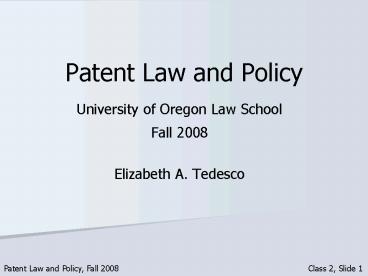Patent Law and Policy PowerPoint PPT Presentation
1 / 9
Title: Patent Law and Policy
1
Patent Law and Policy
- University of Oregon Law School
- Fall 2008
- Elizabeth A. Tedesco
Patent Law and Policy, Fall 2008 Class 2,
Slide 1
2
Patentable Subject Matter
- 35 U.S.C. 101. Inventions Patentable
- Whoever invents or discovers any new or useful
process, machine, manufacture, or composition of
matter, or any new and useful improvement
thereof, may obtain a patent therefor, subject to
the conditions and requirements of this title. - 100. Definitions
- When used in the Patent Act unless the context
otherwise indicates - The term invention means invention or
discovery. - The term process means process, art or method,
and includes a new use of a known process,
machine, manufacture, composition of matter, or
material
Patent Law and Policy, Fall 2008 Class 2,
Slide 2
3
Diamond v. Chakrabarty (1980)
- Claim at issue directed to bacteria
containingat least two stable energy-generating
plasmids, each of said plasmids providing a
separate hydrocarbon degradative pathway. - Definitions of manufacture and composition
of matter - Manufacture the production of articles for use
from raw or prepared materials by giving to these
materials new forms, qualities, properties or
combinations, whether by hand-labor or
machinery. - Composition of matter all compositions of two
or more substances and all composite articles,
whether they be the result results of chemical
union, or of mechanical mixture, or whether they
be gases, fluids, powders or solids.
Patent Law and Policy, Fall 2008 Class 2,
Slide 3
4
OReilly v. Morse (1854)
- Claim at issue Eighth. I do not propose to
limit myself to the specific machinery or parts
of machinery described in the foregoing
specification and claims the essence of my
invention being the use of the motive power of
the electric or galvanic current, which I call
electro-magnetism, however developed for marking
or printing intelligible characters, signs, or
letters , at any distances, being a new
applicable of that power of which I claim to be
the first inventor or discoverer.
Patent Law and Policy, Fall 2008 Class 2,
Slide 4
5
Claiming A Chair With Wheels
Invention
Prior Art
A
A
B
B
B
C
C
C
D
D
E
Smith
Jones
Can the inventor claim
A, B, and C ?
No, anticipated by Smith
A, B, C, and D ?
No, rendered obvious by Smith in view of Jones
A, B, C, D, and E ?
Yes, it is novel and nonobvious!
Patent Law and Policy, Fall 2008 Class 2,
Slide 5
6
The Telephone Cases (1888)
- Claim at issue The method of, and apparatus
for, transmitting vocal or other sounds
telegraphically, as herein described, by causing
electrical undulations, similar in form to the
vibrations of the air accompanying the said vocal
or other sounds, substantially as set forth.
Patent Law and Policy, Fall 2008 Class 2,
Slide 6
7
Morse Claim vs. Telephone Claim
- Morse claim Eighth. I do not propose to
limit myself to the specific machinery or parts
of machinery described in the foregoing
specification and claims the essence of my
invention being the use of the motive power of
the electric or galvanic current, which I call
electro-magnetism, however developed for marking
or printing intelligible characters, signs, or
letters , at any distances, being a new
applicable of that power of which I claim to be
the first inventor or discoverer.
- Telephone claim The method of, and apparatus
for, transmitting vocal or other sounds
telegraphically, as herein described, by causing
electrical undulations, similar in form to the
vibrations of the air accompanying the said vocal
or other sounds, substantially as set forth.
Patent Law and Policy, Fall 2008 Class 2,
Slide 7
8
Parke-Davis Co. v. H.K. Mulford Co.
- Claims at issue
- A substance possessing the herein-described
physiological characteristics and reactions of
the suprarenal glands in a stable and concentrate
form, and practically free from inert and
associated gland-tissue. - The substance consisting of a salt of the
herein-described product of the suprarenal
glands said salt being easily soluble in water
and possessing the physiological and therapeutic
characteristics and reactions of said product in
substantially stable and concentrated form.
- Takamine was the first to make it available for
any use by removing it from the other
gland-tissue in which it was found, and, while it
is of course possible logically to call this a
purification of principle, it became for every
practical purpose a new thing commercially and
therapeutically.
Patent Law and Policy, Fall 2008 Class 2,
Slide 8
9
Funk Bros. Seed Co. v. Kalo Inoculant Co.
- Claim at issue An inoculant for leguminous
plants comprising a plurality of selected
mutually non-inhibitive strains of different
species of bacteria of the genus Rhizobium, said
strains being unaffected by each other in respect
to their ability to fix nitrogen in the
lebuminous plant for which they are specific.
- Bond does not create a state of inhibition or
of non-inhibition in the bacteria. Their
qualities are the work of nature. Those
qualities are of course not patentable. For
patents cannot issue for the discovery of the
phenomena of natureHe who discovers a hitherto
unknown phenomenon of nature has no claim to a
monopoly of it which the law recognizes. If
there is an invention from such a discovery, it
must come from the application of the law of
nature to a new and useful end.
Patent Law and Policy, Fall 2008 Class 2,
Slide 9

